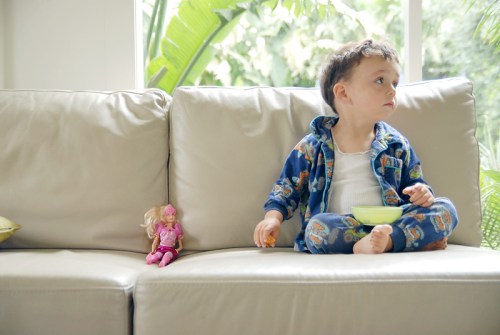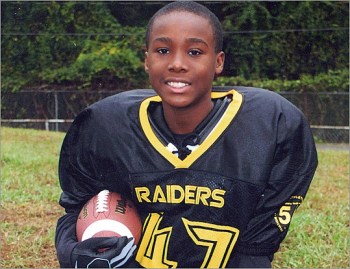Over at Slate, Brian Palmer has a meditation on gay identity and behaviors in young people — especially timely at a point where we’re increasingly aware that ‘acting gay’ can be dangerous for kids, like it was for Lawrence King. Palmer’s question is: we’re worried about our kids being gay-bullied at young ages, but we’ve only recently begun even thinking about young kids being out or gay at all. How can you tell, and how early? For instance, he mentions one of the plaintiffs in the court case about the proliferation of bullying in Minnesota — he’s only fourteen, and hasn’t declared a sexual orientation but is still a victim of antigay bullying. If we can agree that antigay bullying is now a problem for our children, does that mean we can agree that our children can be gay, even at young ages?
Well, probably we’re not going to be able to agree on much of this article at all. Palmer starts with the assertion that gayness (behavior? identity? unclear) can be noted as early as toddler-hood, which is certainly possible and which I’m willing to entertain. But then there’s his examples. For instance:
A hefty pile of research shows that boys as young as 3 years old who break from traditional gender roles have a high likelihood of becoming gay adults. Predictive behaviors include playing with Barbie dolls, shying away from roughhousing, and taking an interest in makeup and women’s clothing.

Palmer explains this as being research-based, but it smacks SO STRONGLY of every stereotype gay people, especially men, have had to live through that it’s almost impossible to stomach. It also sounds almost identical to the ‘research’ and ‘theory’ of ‘scientists’ like Dr. George Rekers, whose ‘therapy’ aimed at gay conversion was based on assumptions that sounded very similar: “According to Dr.Green and the grown homosexual man he brought with him on the show, effeminate male children would almost certainly grow into homosexual men if they weren’t treated by psychiatrists at the earliest age possible. She remembers: “I think there was a listing of ten things. If your little boy is doing, like, five out of these ten things, then contact me. And so that’s how I got into this.”
Is that the kind of ‘research’ that Palmer is thinking of when he says that playing with Barbies is a ‘predictive behavior?’ Why yes! It is! Because the one study he cites is in fact the The “Sissy Boy Syndrome,” which was the exact study run by George Rekers and Robert Green and referred to above. It followed an entire 44 “non-gender-conforming” men and found that, surprise, thirty of them became gay or bisexual adults. The issue, of course, is that this was in fact a seminal work of gay conversion therapy and along with its theories on ‘gender non-conforming behavior,’ it also held that by correcting that behavior, boys could be trained to grow up straight — “cured.” Not that there’s any mention of this in Palmer’s article! In fact, The “Sissy Boy Syndrome” is referred to as “the leading study in this field” — never mind that it was published over 30 years ago, and that Dr. Robert Green, its primary author has since renounced conversion therapy (aka the results of this study), as has the American Psychological Association. This apparently did not seem relevant to include in the article. The one stalwart loyalist from the study, Dr. George Rekers, was caught vacationing with a handsome young ‘rentboy’ he had solicited online. Not that that means he’s gay, or that conversion isn’t real, or that the findings of his faulty study are invalidated — after all, doesn’t Rekers have totally gender conforming behaviors?

None of this backstory to the “leading study” is mentioned in Palmer’s article; he says only that “Green’s study has since been repeated by other researchers with similar outcomes.” What researchers? Were they also misleading and permanently damaging the families of young children? Did their patients also later commit suicide? Can we assume that leaving out even a mention of controversy over these research findings — or citing any studies on non-gender-conforming children after 1987 — is, charitably, a journalistic oversight? Albeit a glaring one? For instance, we have to be generous in our assumption that Palmer was somehow kept in the dark about this 2003 paper in The Journal of Gender Studies, which is the first result after literally typing “gender non-conforming children” into Google Scholar. Its title is “Same-sex Sexuality and Childhood Gender Non-conformity: A spurious connection,” and you don’t even have to read past the abstract to get a counterpoint to Rekers and Green:
“In this paper I present a challenge to the theory that childhood gender non-conformity is associated with homosexuality, noting in particular that discussions of gender non-conformity and ‘homosexuality’ do not attempt to explain the experiences of heterosexual women. By demonstrating that childhood gender non-conformity has been wrongly associated with same-sex sexuality and posing an alternative explanation for childhood gender non-conformity, it is my intention to present a challenge to the theory that same-sex sexuality is related to congenital gender inversion.”
Even so, even if someone were blissfully unaware of the horrific background of the ‘research’ they had stumbled across, wouldn’t there still be some major issues to overlook? For instance, the fact that while any social scientist understands the difficulties in rounding up a good sample size especially for minority communities (or things that parents might be reluctant to make public, like non-conforming gendered behavior), 44 is a ridiculously small sample size. Even though the contrasting evidence, that only one child from a 34-person sample of more ‘normal’ kids turned out to be gay, is sort of striking, the fact is that 34 people isn’t enough to draw any kind of meaningful conclusion from. It didn’t occur to Palmer that there might be something out there that was a little more comprehensive? Or did he know, and just didn’t want to tell you about it?
In short, once the deeply misinformed (at least I hope that’s the reason why this article was written from inside a time capsule) research at its heart is revealed, the rest of the assertions made are nothing short of disturbing. “Gender nonconforming boys also tend to adopt more traditional gender roles in middle and high school, often as an attempt to cover up their sexual identity.” Really? How did we find that out? By watching Glee? Since there’s no mention of any evidence backing it up, it’s really hard to say!
Bullying of gay kids, and kids who aren’t out but are perceived as gay or non-gender conforming, is a life-threatening issue. For instance, the heartrending death of Carl Joseph Walker-Hoover, is hard to forget — he committed suicide at only 11 after enduring constant bullying and “gay” taunts at school. He didn’t identify as gay. At 11, it would be surprising if he did. Brian Palmer may like to know that Carl played football — a pretty gender-conforming behavior, no?

The question of how torment around an alleged sexual identity was allowed to get so bad that he killed himself, or why sexual identity is so concerning to our kids that they’re increasingly losing their lives over it, is urgent and hugely important. We need to do everything we can, all the research and reaching out and reaching inside ourselves, to try to stop something like this from ever happening again. And in the face of that, in a moment when we need to be honest about what’s happening to our kids and our own responsibility in stopping it, it’s positively reprehensible to choose to cling to the old, frightened stories we used to tell ourselves about what we hoped we could turn our kids into.
In the real world, the one we actually live in, playing with Barbies doesn’t mean anything. But making sweeping generalizations about it based on deeply flawed and prejudiced research from thirty years ago? That makes you a bad reporter.
